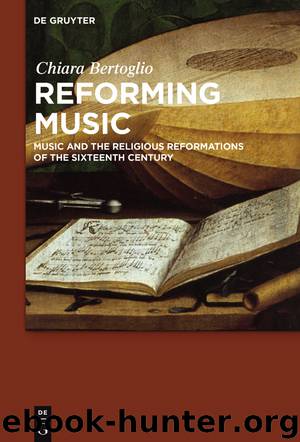Reforming Music by Chiara Bertoglio

Author:Chiara Bertoglio
Language: eng
Format: epub
Publisher: Birkhäuser
Published: 2017-04-25T16:00:00+00:00
9.3.Music and liturgy after Trent
The Council of Trent, advocating the creation of liturgical books to be adopted by the entire Catholic Church, with only few exceptions being granted to ancient rites, aimed at uniformity in the cultual practice of Catholicism (which was characterised by a wide variety of liturgies before the Council).
However, study of Catholic liturgical forms after Trent must take into account that practical differences continued to exist, mirroring diversity at the geographical, social, cultural and spiritual levels, as well as the impact of individuals such as bishops or superiors of religious orders on the musical and liturgical practices of those under their guidance. Of course, time played a non-negligible role as well, both inasmuch as changes in the theological and musical perspectives paralleled those affecting society as a whole, and as the chronological alternation of religious guides sometimes implied a noticeable diversity in the liturgical, spiritual and musical orientation of a religious order or a bishopric over time. This could also mean, obviously, that limitations on music which had been first proposed, but later overruled at the Council, could still be enacted by those spiritual leaders who felt inclined to do so.
The need for a reform within the Catholic Church and its music was commonly felt, before, during and after the Council; however, the interpretation of which reforms were needed and of how they had to be pursued varied greatly, and depended in a significant measure on the spiritual streams vivifying religious life in the Catholic areas. Though there were strong centralising tendencies, they did by no means exhaust the spiritual energies unleashed by the Council, or the variety in the musical and spiritual attempts at reformation and regeneration.
It is important to stress, once more, that there was considerable fluidity between liturgical and sacred repertoire, and between the sphere of religious and that of secular music, in parallel to a social situation in which “the sacred” was still largely intertwined with what we would today define as secular. Notwithstanding the religious people’s recurring concerns that nothing “secular” should enter into close contact with the “sacred” (cf. the worries about ritual purity in music, clergy etc.), the sacred still maintained a public dimension which is largely lost today, and which impacted strongly on the political, economic and social lives of an urban or (even more so) a rural community.
Though classifications are always rigid and schematic, they cannot be avoided for the sake of clarity; however, I would argue that the distinctions between sacred, secular, liturgical etc. are best understood as a continuum ranging from the strictest and purest forms of liturgical music (which I think can be identified with plainchant) to works of an entirely secular character, and comprising, within itself, Mass settings, Magnificats and other works for the Liturgy of the Hours or other official liturgies (e. g. Office of the Dead), motets, spiritual songs (in accompanied monody or polyphony, or suitable for both), lauda-style songs, litanies, processional songs and so on.
Only a few of the genres listed
Download
This site does not store any files on its server. We only index and link to content provided by other sites. Please contact the content providers to delete copyright contents if any and email us, we'll remove relevant links or contents immediately.
The Lost Art of Listening by Michael P. Nichols(6475)
Why I Am Not A Calvinist by Dr. Peter S. Ruckman(3771)
The Rosicrucians by Christopher McIntosh(3051)
Wicca: a guide for the solitary practitioner by Scott Cunningham(2706)
Signature in the Cell: DNA and the Evidence for Intelligent Design by Stephen C. Meyer(2502)
Real Sex by Lauren F. Winner(2477)
The Holy Spirit by Billy Graham(2419)
To Light a Sacred Flame by Silver RavenWolf(2355)
The End of Faith by Sam Harris(2292)
The Gnostic Gospels by Pagels Elaine(2027)
Nine Parts of Desire by Geraldine Brooks(2008)
Waking Up by Sam Harris(1959)
Heavens on Earth by Michael Shermer(1955)
Devil, The by Almond Philip C(1901)
Jesus by Paul Johnson(1889)
The God delusion by Richard Dawkins(1850)
Kundalini by Gopi Krishna(1825)
Chosen by God by R. C. Sproul(1763)
The Nature of Consciousness by Rupert Spira(1690)
